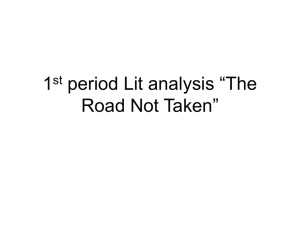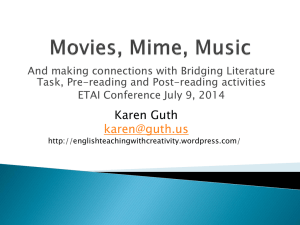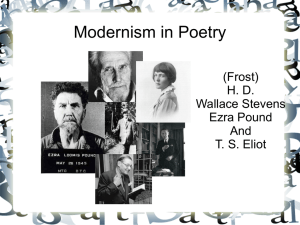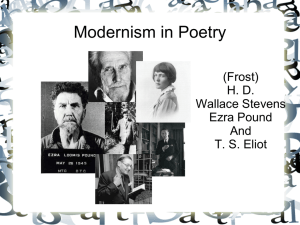Robert Frost - Sites at Penn State
advertisement
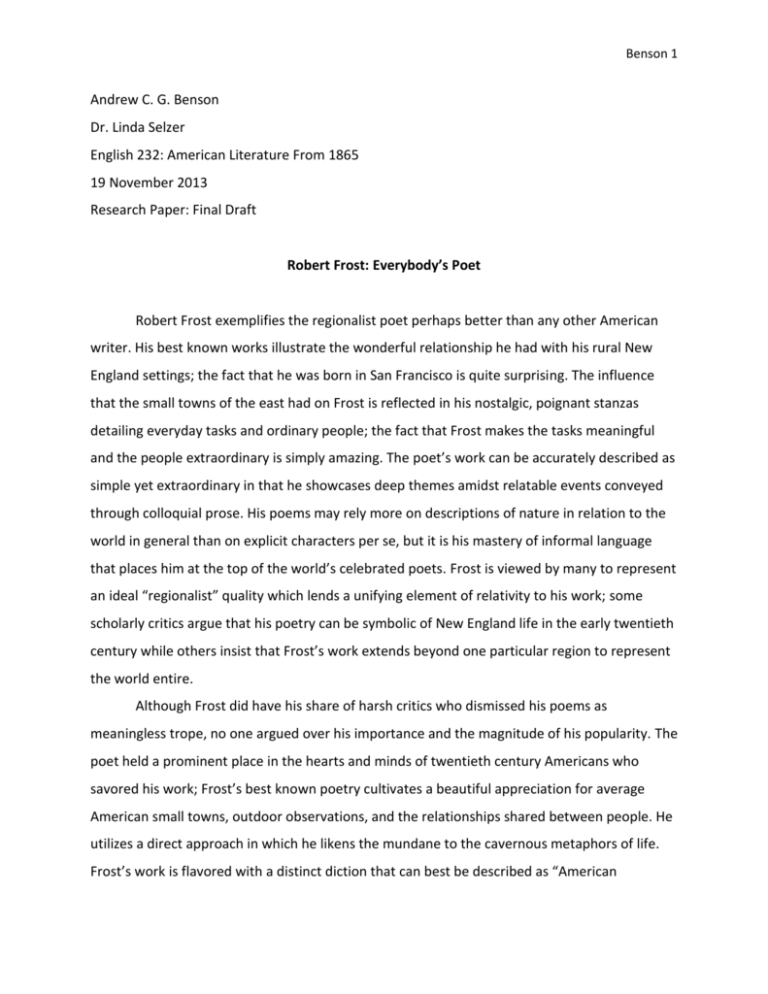
Benson 1 Andrew C. G. Benson Dr. Linda Selzer English 232: American Literature From 1865 19 November 2013 Research Paper: Final Draft Robert Frost: Everybody’s Poet Robert Frost exemplifies the regionalist poet perhaps better than any other American writer. His best known works illustrate the wonderful relationship he had with his rural New England settings; the fact that he was born in San Francisco is quite surprising. The influence that the small towns of the east had on Frost is reflected in his nostalgic, poignant stanzas detailing everyday tasks and ordinary people; the fact that Frost makes the tasks meaningful and the people extraordinary is simply amazing. The poet’s work can be accurately described as simple yet extraordinary in that he showcases deep themes amidst relatable events conveyed through colloquial prose. His poems may rely more on descriptions of nature in relation to the world in general than on explicit characters per se, but it is his mastery of informal language that places him at the top of the world’s celebrated poets. Frost is viewed by many to represent an ideal “regionalist” quality which lends a unifying element of relativity to his work; some scholarly critics argue that his poetry can be symbolic of New England life in the early twentieth century while others insist that Frost’s work extends beyond one particular region to represent the world entire. Although Frost did have his share of harsh critics who dismissed his poems as meaningless trope, no one argued over his importance and the magnitude of his popularity. The poet held a prominent place in the hearts and minds of twentieth century Americans who savored his work; Frost’s best known poetry cultivates a beautiful appreciation for average American small towns, outdoor observations, and the relationships shared between people. He utilizes a direct approach in which he likens the mundane to the cavernous metaphors of life. Frost’s work is flavored with a distinct diction that can best be described as “American Benson 2 colloquialism;” this language is not shallow or uneducated as some would claim it to be but rather enjoyable and incredibly relevant. Colloquialism stretches from everyday discourse between middle-class people to children’s’ unique perspectives on the world we live in. Frost was reputable for his connection to the people, his poetry free of the intricate language barriers that were common among the majority of Frost’s contemporaries; with Frost, poetry became accessible to a much wider population not just because of his idiosyncratic style, but also due to the subjects in his writing. Examples of the linguistic stimulation that is colloquialism include figures of speech such as “raining like cats and dogs” and “dead as a doornail” which are not meant to be taken literally but resonate with folks nonetheless; other examples can be found in wise, witty aphorisms like “There is more than one way to skin a cat” and “One can catch many flies with only a little bit of honey.” These language devices are common amongst everyday people and surely an accurate glimpse into the lives of the New Englanders Frost described in his poetry. The word “kid” almost always refers to an actual human child as opposed to a baby goat, while the word “pop” is a handle for “soda” in some regions; the unique colloquialisms of respective regions throughout the United States account for the rich contextualization present in poems which seek to work in said colloquialisms and Frost’s work is perhaps the pioneering trailblazer of this concept. According to John Kemp, who has studied Frost as a regionalist in different terms, New England’s “distinctive verbal and linguistic traits” result in New England thriving as a specific region which sports “a lively and colorful language, flourishing with pithy idioms…and vivid figures of speech.” Kemp states that Frost wrote his poetry with the persona of a certain type of “Yankee character” in mind, a type that is hard to discern from other character types but ultimately accurate within the New England setting. Frost sought to bring the everyday to the forefront of American poetry by depicting a language that was relevant to the people he was writing about, as those same people would also be readers (Kemp 6). Frost is often compared with Carl Sandburg, another poet who rose to prominence through depiction of a particular region’s way of life. Sandburg’s work does indeed share the colloquial habits and realistic sentiments of Frost’s despite the former’s being a bit more familiar with city commentary. Both men seemed to recognize the importance of colloquial language in terms of Benson 3 storytelling authenticity. Frost’s true territory proved to be the smaller, quieter parts of the country; he had become immersed in his own resident region. Frost’s penchant for the common man and the natural, simple beauty of his surroundings was the essential component to his success as a poet. His oft-quoted “Stopping By Woods On A Snowy Evening” showcases his ability to capture a profound and deep metaphor via observation of scenery and environment. Included in his seminal 1923 collection titled New Hampshire, the aforementioned poem finds Frost as a narrator who comments on his gazing into a white abyss while his horse “must think it queer” to have stopped in heavy snow on “the darkest evening of the year.” Frost declares that while the winter woods are captivating and the season of cold and limited light has made him weary, he must press on: “The woods are lovely, dark and deep, / But I have promises to keep, / And miles to go before I sleep…” (Frost 87). Frost’s mediation on life and death amidst the defining characteristics of a particular season highlight this poem; his metaphor deals enigmatically with the mystery of the great unknown in such elegant terms. The poem “Nothing Gold Can Stay” has Frost commenting on the parallels between nature and life overall; in only eight lines he connects the growth and eventual demise of nature with birth and death. While the poem itself is known for its simplistic depiction of rural nature, its contents are indeed exclusive to the Northeast; “Nature’s first green is gold, / Her hardest hue to hold. / Her early leaf’s a flower; / But only so an hour.” These lines illustrate the concept of time and how fast it goes; beauty is beloved but ultimately fleeting. Frost creates a poem that is set within a universal atmosphere; his readers can deduce that the setting is small town New England, yet the overall essence of this work can be observed in any place throughout the world. Youth only lasts so long, and we love a rose because we know it will soon be gone. The beauty Frost speaks of as he observes and embraces his outdoor surroundings culminates with his acceptance of its mortality; “Then leaf subsides to leaf. / So Eden sank to grief, / So dawn goes down to day. / Nothing gold can stay” (Frost 84). The author uses this accessible setting to form his best method of effective writing, that of the deep philosophical theme regarding precious time in correlation to living and dying; his brief but powerful look at Benson 4 this concept further places him in the realm of a regionalist poet as well as a deep thinker who communicates incredibly well in his writings. Rhyming is an important technique for Frost; while many successful poets such as Walt Whitman did not rhyme often, Frost values rhyme scheme and makes the case that truly brilliant poetry should seek to rhyme. This technique is certainly taken for granted in the world of poetry and Frost’s creations such as “Nothing Gold Can Stay” and “Stopping By Woods On A Snowy Evening” are seen as masterpieces primarily because they rhyme evocatively while simultaneously offering a complex probing of critical philosophical wonder. Frost’s genius lays within his formula of efficient rhyming, profound and stimulating metaphorical study, and his overall authenticity in depicting everyday observation with such vibrant emotions and moving lyrical prose. The two previous poems are of note for all of these reasons; they are clear and concise, brief and to the point, yet maintain their own respective airs of complexity and interpretive substance. While Frost’s work exhibits a language that is region-specific, one must recognize that the colloquial language of many different regions yields a plethora of interesting lexicons. These relaxed but effective languages lend character and quality to a region, as well as to a place and a time; whether one views Frost as a regionalist or as a poet representative of something much bigger, one must acknowledge that different colloquial dialects are the salt of intriguing writing. Frost will be forever associated with New England as his very name evokes images of autumn leaves, giant sentry-like oak trees, marvelously green landscapes, and the daily goings on of everyday people. His is an artist in that his portraits of this simple but meaningful kind of life lend themselves to the dreams of many, the longing for an idyllic existence. His regionalist colloquialism can perhaps best be summarized with an original aphorism of his from “Mending Wall” in which he writes “Good fences make good neighbors.” This sentiment does not reflect in a positive light, but nonetheless it signifies Frost’s affinity for crafting wonderful adages as well as utilizing pre-existing mottos remarkably well within his work. Colloquial language is made up of many aphorisms which are meant to supplement the wisdom of people; Frost’s usage of this sub-genre of language complements his work and adds a human touch to his poems which are already nurtured in humanity nonetheless. Frost expressed his belief that the Benson 5 only thing he knew for sure about life itself was that “it goes on” and even asked the almighty for forgiveness by lamenting “Forgive, O Lord, my little jokes on Thee / And I’ll forgive Thy great big one on me” (Bloom 10). It is the universality of Frost that has made the man and his work immortal; his view of the world through an idiosyncratic lens has led his loyal audiences to contemplate a snowy evening and a mending wall, to appreciate the stunning beauty of autumn foliage and a farmer’s plough. His perspective has divided critics, but there are some certainties about the poet: he offered his most personal thoughts to an audience and occasionally disguised them as an easterly breeze or a walk down a less-traveled path. Frost can be described as a regionalist for sure but that is by no means his only claim to the world; his work reaches far beyond one area of one country. His subjects are relatable to all people and his messages transcendent of time; his work is not dense or kitschy, it is pure and graceful in its conception and inspired by the real world. It is a world of which Frost conveys the most absorbing elements coupled with the most beautiful aspects of life to produce everlasting anecdotes on existing. He contributed greatly to the cultural milieu that is twentieth century American poetry simply by maintaining an identity in his writing and that identity, regardless of what critical stance one adopts, always seems to resemble a keen witness to ordinary splendor and magnificence. Frost’s eloquence and articulate manner of speaking in his writing is a result of his region and his own character. * Benson 6 Bibliography Barry, Elaine. Robert Frost. New York: Ungar Publishing Co., 1973. Print. Bloom, Harold. Robert Frost. New York: Chelsea House Publishers, 1986. Print. Frost, Robert. New Hampshire. New York: Henry Holt and Company, 1923. Print. Greiner, Donald J. Robert Frost: The Poet And His Critics. Chicago: American Library Association, 1974. Print. Kemp, John C. Robert Frost and New England: The Poet As Regionalist. Princeton: Princeton University Press, 1979. Print.




